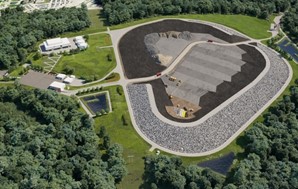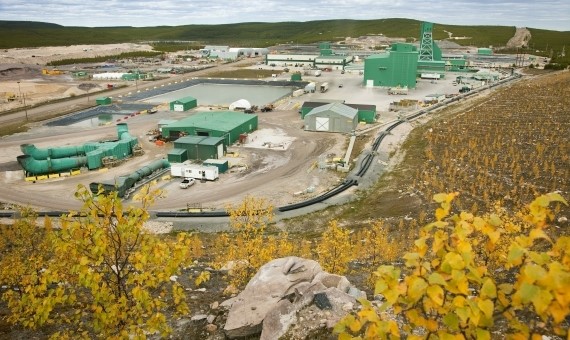A rendering of Canadian Nuclear Laboratories’ proposed Near Surface Disposal Facility. (Image: CNL)
Canadian Nuclear Laboratories (CNL) is asking its stakeholders (members of the public, industry, elected officials, and employees) to support a proposal to construct the Near Surface Disposal Facility (NSDF) to dispose of legacy radioactive waste at the Chalk River Laboratories in Ontario.
The NWMO said its Property Value Protection program satisfies one of the guiding principles set out to support local decision-making about Canada’s repository project. (Photo: NWMO)
Canada’s Nuclear Waste Management Organization (NWMO) said in a February news release that it has developed a program to protect the value of properties near the potential site in South Bruce, Ontario, for the country’s deep geological repository for used nuclear fuel. Along with Ignace in western Ontario, South Bruce is one of the two potential locations the NWMO has identified for hosting a deep geological repository.
According to the NWMO, the Property Value Protection program reflects a responsible commitment to the community and addresses questions the organization heard from residents about whether property values will be affected if South Bruce is selected for the repository. The program, which was developed in consultation with the community of South Bruce, will compensate residents if the sale of their properties is negatively affected by the project.
Mining at McArthur River takes place between 530 and 640 meters belowground. (Photo: Cameco)
Citing “improving market sentiment,” Tim Gitzel, president and chief executive officer of the Canadian uranium mining company Cameco, announced on February 9 the planned restart of operations at the McArthur River mine in Saskatchewan.
Bruce nuclear power plant in Ontario, Canada. (Photo: Bruce Power)
Bruce Power and Isogen, a partnership between Kinectrics and Framatome, have completed the installation of Isogen’s isotope production system (IPS) at Unit 7 of Bruce’s CANDU nuclear power plant in Ontario, Canada, making it the first power reactor in the world with installed capability to produce lutetium-177.
The young Jimmy Carter, years before his presidency. (Click to view entire graphic.)
Jimmy Carter is trending on Twitter this week because of his ties to nuclear power. Carter, the 39th president of the United States, was a member of Rickover’s nuclear navy about 70 years ago when he was assigned to help in the aftermath of an accident at the Chalk River Laboratory in Ontario, Canada.
Research teams from the NWMO and the University of Guelph conduct eDNA sampling in the Ignace area of Ontario, Canada. (Photo: NWMO)
Canada’s Nuclear Waste Management Organization (NWMO) is working with the University of Guelph to launch a joint environmental DNA (eDNA) research program to further understand biodiversity conditions around two potential sites in Ontario for a deep geological repository for spent nuclear fuel.
In a virtual ceremony, CNL and KHNP signed a memorandum of understanding to cooperate on spent CANDU fuel research. (Image: CNL)
Canadian Nuclear Laboratories (CNL) and Korea Hydro and Nuclear Power (KHNP) intend to leverage data collected over decades on the dry storage of spent nuclear fuel to help inform decision-making on future spent fuel storage, transportation, and disposal activities.
A PET imaging machine. (Photo: Wikimedia Commons)
ARTMS, a Canadian producer of medical isotopes, announced that it has registered the cyclotron production of gallium-68 with the government of Canada, filing a Type 1 Master File with the Health Products & Food Branch of Health Canada. The Ga-68 radioisotope is used in nuclear medicine diagnostic procedures utilizing positron emission tomography (PET) imaging.
The Bruce nuclear power plant in Ontario, Canada. (Photo: Bruce Power)
Bruce Power has received approval from the Canadian Nuclear Safety Commission (CNSC) to begin the production of lutetium-177, becoming the first power reactor globally to commercially produce the medical radioisotope. Isogen, a joint venture between Framatome and Kinectrics, will produce Lu-177 at Bruce’s eight-unit CANDU nuclear power plant in Ontario, Canada, using Isogen’s isotope production system (IPS).
The core of SLOWPOKE-2. (Photo: CNL)
Canadian Nuclear Laboratories (CNL) announced on September 23 that it had refueled the SLOWPOKE-2 research reactor at the Royal Military College of Canada (RMC) in Kingston, Ontario. The reactor was recommissioned on September 10 after a 22-day outage.
NWMO geologists study rock formations in the Ignace area of Ontario, Canada.
Canada’s Nuclear Waste Management Organization is studying the geology of the Ignace, Ontario, area to confirm its suitability as a site for a deep geologic repository for spent nuclear fuel and high-level radioactive waste. Ignace is one of two areas the NWMO is investigating as possible host sites for a repository, with South Bruce, Ontario, being the second area.
Canada’s pickering nuclear power plant. (photo: opg)
A collaboration agreement signed by Ontario Power Generation’s Center for Canadian Nuclear Sustainability, Canadian Nuclear Laboratories, and SNC-Lavalin will build on Ontario’s extensive nuclear industry expertise and skilled workforce to support the decommissioning of CANDU reactors in Canada and around the world, according to a May 13 press release from the organizations. The work will include the decommissioning of OPG’s Pickering nuclear power plant following the end of commercial operations in 2025.


















